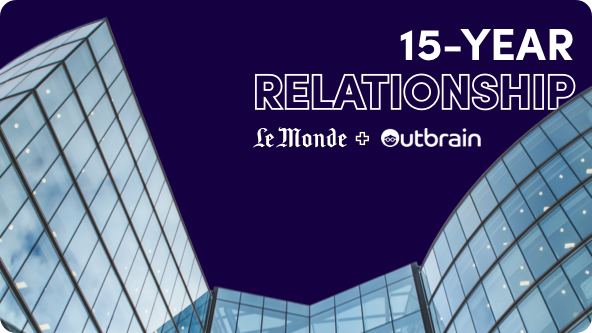Our Guiding Lights: Why We Founded Outbrain and How We Lead It

Ori and I founded Outbrain out of a deep passion for stories and great storytelling, as manifested in the newspapers, magazines, and blogs that we love.
When we pioneered the space of recommendations for publishers, there were two areas we viewed as broken:
- The content experience: In the haystack of the Internet, it was near impossible to find a delightful needle of a story.
- The advertising experience: The main business model for publishers – advertising – seemed challenged in the long term because it so often delivered a bad user experience.
We founded Outbrain with a clear goal of fixing these two key problems, thereby helping users get a better experience while ensuring that publishers can remain sustainable and thrive.
Fast forward to today, and Outbrain is a global leader in monetization and user engagement for publishers and media owners. Over the past decade, in the 18 countries Outbrain operates in, we have generated over $3B+ in direct revenue for our partners. Supporting some of the world’s most prestigious news organizations, this number represents a tremendous amount of journalism and editorial resources that otherwise might not have existed. We are incredibly proud of Outbrain’s profound contribution to sustaining journalism, local news, and independent publishing.
Trying to explain how we achieved this, and how we think about the future, is not trivial, as some of the key pillars of our strategy can at times sound counterintuitive. We hope you’ll find this interesting
Our core, contrarian, thesis
At the core of Outbrain is a thesis that is contrarian to much of the broader market we operate in – the digital advertising market. Since our core approach to making money is contrarian, it is sometimes misunderstood.
Online advertising has three constituents that participate in the value exchange:
- The publishers (or media owners) that create the content
- The advertisers that pay to be featured alongside the content
- And the people who consume the content and ads.
All three constituents are critically important for this value exchange, yet one constituent is oftentimes ignored – the consumers of content.
Outbrain’s model flips that by focusing on the consumer first. In fact, we refer to the consumer as ‘Our Boss’.
This contrarian approach manifests itself in one particular way – how ads are typically priced and prioritized online. As a rule of thumb, most companies that facilitate online advertising will typically sort ads from those priced highest down to the cheapest, and show you, the consumer, the priciest ads they’ve been able to sell.
Herein lies the conundrum of how such a vast industry with so much technology, ends up serving so many ads that are so underwhelming to all of us:
At Outbrain, we know that ‘Our Boss’, the consumer, is interested in many different things: She’s interested in politics, and technology, in sports, and entertainment.
We also know for a fact that there is one thing she is NOT interested in at all – the price of the ads served to her.
We have yet to find a person who has consumed any form of media and said: “That ad is so delightfully priced! I have to spend more time on this site!”
More likely, if the content and advertising user experience are not great, the consumer is not likely to come back tomorrow.
This is why our core thesis is predicated on the long-term behavior patterns of the consumer. We like to think that we are ‘long-term greedy’, as we don’t optimize for the specific ad, but rather, for the long-term revenue stream that the user represents. For example, we believe that across our industry, when most companies need to select between two ads, one priced at $1.00 and the other at $0.80, they will automatically choose to show the $1.00 ad.
In contrast, at Outbrain we ask: “Between these two ads – which is more likely to result in the consumer engaging more with this publisher in the future?”. If our predictive AI models indicate that the consumer’s engagement is more likely to compound over time if we choose the $0.80 ad – that is what we will choose to serve.
The price paid by our advertisers is determined by the advertisers, not by Outbrain. In most industries and most companies, pricing power is considered an important indicator of a businesses’ strength. At Outbrain that is not necessarily true. The reason is that we always aim to first grow our revenues based on user engagements, and not through price. Again, if we can get 2 (or more) user engagements at $0.80 each, or even $0.50 each, we will much prefer that than getting 1 user engagement at $1.00.
While our contrarian model requires patient discipline, we believe that it will be rewarding in the long run for several reasons:
First – the compounding effect:
Prices of ads, like any other product, can fluctuate. They can go up or down based on supply-vs-demand, seasonality, competition, geography, etc, etc. The price an advertiser was willing to pay during March of last year has little to do with the price the same advertiser will be willing to pay next December, right before Christmas.
In contrast, user engagement compounds over time. If a consumer (‘Our Boss’) clicked on a link, or visited a site, and had a good user experience – she is slightly more likely to come back tomorrow. And if she indeed comes back tomorrow and again has a good user experience – she’s slightly more likely to engage again the day after. And so forth and so on, for many years to come.
So while the entire industry seems to be obsessed with grabbing the highest priced ad regardless of the long-term impact on users, Outbrain focuses on the gradual compounding effect of user engagement.
Second – Return-On-Ad-Spend (ROAS):
When we choose to serve ads that are more engaging rather than pricier, that translates to lower prices that our advertisers have to pay. Again, in most industries, this might be viewed as a lack of pricing power. However we see tremendous value in this, as it helps drive superior value, typically referred to as Return on Ad Spend (ROAS), for the advertisers that choose to spend on Outbrain.
In the long run, advertisers choose to spend more money on the platforms that deliver them the best returns on ad spend. As at Outbrain we prefer to opt for the long-term compounding effects, rather than capture short-term pricing fluctuations – we prefer to charge advertisers less per user engagement, but collect from them more total spend for more user engagements over time.
To refer back to the pricing example above, our unique approach to the business means that our pricing power should not be derived from pricing per se – when we select an $0.80 ad vs a $1.00 ad, we knowingly chose the lower-priced one. Instead, our pricing power should be derived from the yield that we generate for our partners and for ourselves. In this example, if we were able to gain two user engagements, we yielded in the long-term $1.60 while our competitors yielded only $1.00. And we did that while at the same time delivering 20% better value and higher ROAS for our advertisers.
These tradeoffs, while counterintuitive, are ones we’ll always attempt to make at Outbrain as we believe they will serve our business, and thus our shareholders, well in the long term.
Lastly – the deep nature of our partnerships:
Since the Outbrain model optimizes for the user’s experience, it works best when Outbrain powers a Media Owners’ entire feed of recommendations. Unlike many advertising technology companies that occasionally serve an ad in a variety of places, Outbrain’s default model is to exclusively power 100% of our partner’s recommendation feed, including all of the content, videos, ads, etc that are within it.
We hope that laying out the driving philosophy behind how we run our business will help you understand our framework for making decisions. Since founding the company, we have led it in light of the values and aspirations which we have attempted to summarize in our company’s “Culture Manifesto” which is publicly available on our website, and we encourage you to take a look.
Yaron Galai & Ori Lahav, Co-Founders of Outbrain














